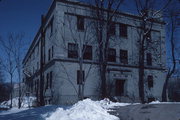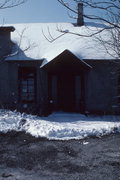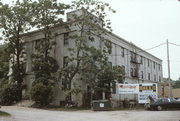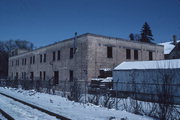| Additional Information: | A 'site file' exists for this property. It contains additional information such as correspondence, newspaper clippings, or historical information. It is a public record and may be viewed in person at the Wisconsin Historical Society, State Historic Preservation Office.
The White Rock Mineral Spring complex includes two buildings associated with the bottling industry. The bottling house is a three story building constructed of concrete. Pilasters and string courses articulate the walls, which are pierced by rectangular windows. The most interesting features of the design is the front entrance, framed by battered posts supporting a simple entablature. The White Rock name and decorative tile work accent the entrance. The building was considered to be in good condition in 1982, before its demolition. Also in 1982, SCD Inc. of 1702 White Rock Avenue owned the structure.
West of the bottling house is a one story structure, topped by a gable roof. The exterior walls are covered with stucco. According to the Sanborn Perris Map of 1922, this building housed offices, storage and shipping space. [D]. Attached to the northeast side of this building is a brick warehouse building which stands thre stories high on the west side. Attached to the south of this building is a newer, two-story brick warehouse building.
A badly deteriorated springhouse lies west of the original bottling works. This springhouse was not the ornate pavillion-type which was popular during the Spring Era. Instead, this is an octagon, single-story concrete building with very little ornamentation except for the name "White Rock" in tile over the door. The roof of the springhouse has fallen in and the interior is filled with debris.
Historical Statement:
The White Rock Mineral Spring Co. complex is significant as a reminder of this company, which at one time was one of the most prominent mineral spring water companies in the United States. Although the Bethesda Spring water was the first sold nationally, White Rock eventually surpassed it, gaining a national and international reputation.
The spring was discovered in 1870 and was originally called the Still Rock Spring. The first sale of the spring water was made in 1871 by H. N. Colver, the owner of the property. He continued to operate a small bottling business until 1882 when the property was sold to the Chicago drug firm of Gale and Blochi. At some point in the ten years Colver owned the property, the area around the spring was landscaped and a spring house constructed. [B].
Charles Welch managed the operation for Gale and Blocki and eventually acquired the company from them. It is Welch who has been credited with the marketing skills which turned White Rock from just another local bottling company to a nationally known concern. In the 1890s Welch started the first production of soda pop using spring water in the state. In 1893, the company adopted the nypmph "Psyche" as its trademark which became one of the early nationally known logos. In more modern form, this trademark is still used by the company which now owns the name.
In 1908, Welch sold the company to the National Water Comapany of New York for a reputed $1,000,000. According to City Directories, he left his home next to the plan sometime shortly thereafter. [B, C].
The warehouse building was opened in 1913 as part of upgrading the plant. [A, B]. The building originally housed the bottling works and most other functional operations of the plant. [D]. The company was sold again in 1914 to White Rock Mineral Springs Co. and in 1944 to National Distilleries. The plant closed in the 1970s and no bottling operations remained in Waukesha, although the company still operates in New York. The building is historically significant because of its association with the development of a locality. It's period of significance is 1913 to its closing in the 1970s.
2014: No longer extant. |
|---|





